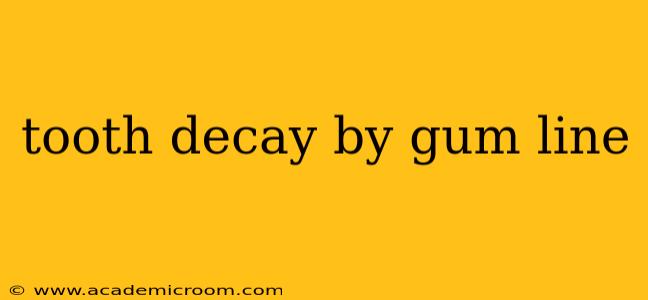Tooth decay, also known as dental caries, is a common problem that can occur anywhere on the tooth. However, decay near the gum line presents unique challenges due to its location and the difficulty in accessing it for cleaning and treatment. This article will explore the causes, symptoms, and treatment options for tooth decay at the gum line.
What Causes Tooth Decay at the Gum Line?
Several factors contribute to tooth decay developing at the gum line:
-
Plaque Buildup: Plaque, a sticky film of bacteria, constantly forms on teeth. If not removed through brushing and flossing, it produces acids that attack tooth enamel. The gum line is a particularly vulnerable area because food particles and plaque can easily get trapped there.
-
Poor Oral Hygiene: Inadequate brushing and flossing allow plaque to accumulate, increasing the risk of decay. Many people neglect cleaning the gum line thoroughly, creating an ideal environment for bacteria to thrive.
-
Receding Gums: As gums recede, more of the tooth root is exposed, making it susceptible to decay. The root surface is less resistant to acid attacks than enamel.
-
Sugary and Acidic Foods and Drinks: Frequent consumption of sugary and acidic substances provides fuel for bacteria, accelerating the decay process. The longer these substances remain in contact with the teeth, the higher the risk of decay.
-
Dry Mouth: Saliva plays a vital role in neutralizing acids and washing away food particles. Dry mouth (xerostomia), caused by certain medications or medical conditions, increases susceptibility to decay.
What are the Symptoms of Tooth Decay at the Gum Line?
Early stages of gum-line decay may be asymptomatic, making regular dental checkups crucial. However, as the decay progresses, you may experience:
-
Sensitivity to Hot and Cold: This is a common early sign, indicating that the enamel is compromised and the dentin (underlying layer of the tooth) is exposed.
-
Discoloration: The affected area may appear darker than the surrounding tooth structure.
-
Pain: As the decay deepens, pain, especially when chewing or biting, may develop.
-
Swelling or Redness of the Gums: If the decay reaches the pulp (the soft tissue inside the tooth), an infection can occur, leading to gum inflammation.
-
Bad Breath: Decaying teeth emit a foul odor.
How is Tooth Decay at the Gum Line Treated?
Treatment depends on the severity of the decay:
-
Fluoride Treatments: In the early stages, fluoride treatments can help strengthen the enamel and prevent further decay.
-
Fillings: For moderate decay, a filling is typically used to remove the decayed portion and restore the tooth's structure. This might involve techniques like composite resin fillings or inlays/onlays for more extensive damage.
-
Crowns: In cases of severe decay, a crown may be necessary to protect the remaining tooth structure. A crown completely covers the tooth, providing strength and preventing further damage.
-
Root Canal Treatment: If the decay has reached the pulp, a root canal may be required to remove the infected tissue and save the tooth. This involves cleaning, shaping, and filling the root canals followed by placing a crown.
-
Extraction: In some instances, if the damage is too extensive, extraction may be the only option. This would then need to be followed up with replacement options like bridges or implants.
What if I have Gum Recession and Tooth Decay?
Gum recession exposes the root surface, which is more susceptible to decay. Treatment in these cases often involves addressing both the gum recession and the tooth decay. This might include gum grafting to cover exposed roots, along with fillings or other restorative procedures to treat the decay.
How Can I Prevent Tooth Decay at the Gum Line?
Prevention is key:
-
Maintain Excellent Oral Hygiene: Brush your teeth thoroughly twice a day using fluoride toothpaste and floss daily, paying special attention to the gum line.
-
Regular Dental Checkups and Cleanings: Visit your dentist for regular checkups and professional cleanings to detect and treat decay early.
-
Healthy Diet: Limit sugary and acidic foods and drinks.
-
Fluoride: Use fluoride toothpaste and consider fluoride mouthwash.
Can I use mouthwash to prevent decay at the gum line?
Therapeutic mouthwashes containing fluoride can help strengthen tooth enamel and reduce the risk of decay. However, mouthwash is a supplement to brushing and flossing, not a replacement.
Addressing tooth decay at the gum line promptly is crucial to prevent further complications and preserve your oral health. Regular dental visits and diligent oral hygiene are the best ways to prevent this issue from arising. Remember to consult your dentist for personalized advice and treatment.
